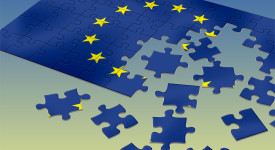EU leaders wrapped up their latest and also last summit in 2014 in the early hours of 19 December, thus breaking with the two-day summit tradition, making leaders and journalists happy by going home before midnight. Normally, EU summits start on Thursday evenings, run late into the night and continue until Friday afternoon. The high-level meeting was also the first high-level appearance for new EU Council chief Donald Tusk, the Polish former prime minister, who began the job only some three weeks ago. After three months of taking intense English language lessons to prepare for the EU’s top job, Mr Tusk admitted to have “felt like a debutant” and have “stage fright”. With the Council conclusions kept to four pages, compared to the 26 pages at the summit exactly one year ago, this EU summit focused primarily on European Commission chief Jean-Claude Juncker’s investment plan and EU sanctions and strategy to deal with Russia.
However, the new Council chief managed to hold a short summit because difficult discussions were avoided. In particular, while EU leaders endorsed the creation of a new investment fund, they also avoided any contentious issues, namely for which projects the funds will be used or also if the money will be included into Brussel’s calculations and assessments whether debt and deficit rules are being breached. As to the discussion on EU’s sanctions and strategy with respect to Russia, EU Council only reiterated the status quo, which revolves around the fundamental principles that Europe doesn’t trust Russian president Vladimir Putin and that sanctions can only be reduced if Russia rolls back its incursion into Ukraine. As a senior EU official noted for EUBULLETIN, “This meeting was not only short and concise but also safe and careful. But the new Council President will sooner rather than later need to go for real decisions.”







